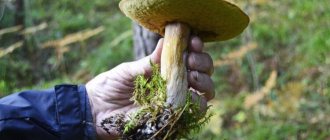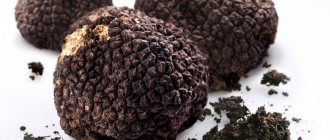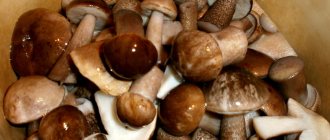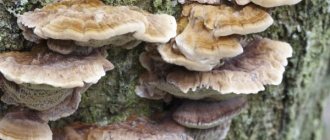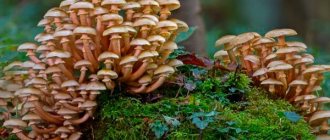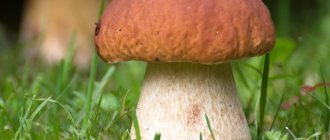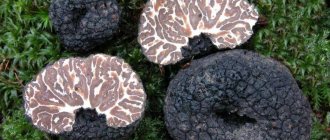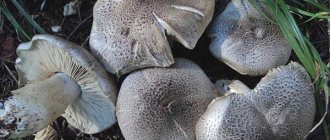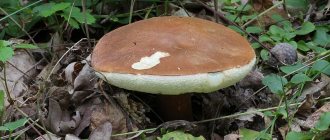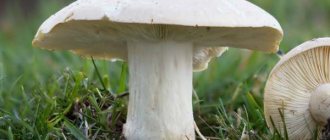General information about the mushroom
Butterworts belong to the department Basidiomycetes, class Agaricomycetes, order Boletaceae, family Oleaceae, genus of oilers. This mushroom gets its name from its oily cap. However, a more interesting and original name for this representative of the mushroom kingdom is used in scientific circles. Scientists call it Suillus - this is from the Latin word sus, which means “pig”. This is again due to the “fat” cap of the oiler. In other countries, the mushroom also received names that emphasize the peculiarity of its cap.
Interesting Facts
Butter mushrooms, photos and descriptions of which you can find in the article below, have several interesting features. These are exactly what I would like to talk about:
- fresh boletus has a minimum calorie content - 19 kcal per 100 grams;
- in England and Germany, a large number of people consider boletus poisonous;
- the benefits of these mushrooms for the human body are enormous, for example, they are rich in vitamin D;
- boletus are found everywhere except in areas with permafrost;
- boletus are so unpretentious that they are found even in Africa;
- these mushrooms always grow in groups, so once you find an oil can, search around;
- Interested in when to collect boletus? Peak growth occurs in August;
- in Chernobyl these mushrooms were planted to artificially reduce the level of radiation;
- in the tropics there is a species of butterfish, the mucus of which is capable of dissolving some insects.
Types of butter
The most popular and widespread is the yellow-brown oiler, followed by the red oiler in terms of prevalence. But these are not the only types of boletus that grow here in Russia, and even more so in the rest of the world. We can highlight 7 of the most common and popular butter mushrooms in our country, which every mushroom picker should definitely get to know, at least in theory. It is advisable to know them before collecting, so as not to accidentally confuse them with false mushrooms.
The most popular and widespread is the yellow-brown oiler
Granular oiler (summer) – Suillus granulatus
Mycorrhizal fungus with pine trees, grows alone or in groups; widespread. The cap is 5-15 cm, arched, becomes a wide arch over time, has a smooth feel, sticky or slimy texture. Changes color from dark yellow, yellow or pale brown to dark brown or brown-orange. With age, the color fades and becomes patchwork with different shades. The veil disappears.
The surface of the pores is initially whitish, then turns yellow, often with droplets of cloudy liquid in young mushrooms. The tubes are about 1 cm deep. The pores are about 1 mm in mature specimens. Leg without a ring, white, with a bright yellow tint near the apex or the entire leg, 4-8 cm long, 1-2 cm thick, equal to or with a cone-shaped base. The top half contains tiny, brown or brownish glandular dots. The flesh is initially white, but in adult mushrooms it is pale yellow and does not stain when exposed. The smell and taste are neutral.
Larch oiler – Suillus Grevillei
The leaf butterfly fungal mycelium and tree roots exchange nutrients for the mutual benefit of both organisms. The cap is pale yellow, bright chrome yellow or bright rusty yellow, wet after rain and shiny even in dry weather. The diameter ranges from 4 to 12 cm at maturity and becomes almost flat sometimes conical or with a noticeable raised central area. The caps of large specimens are somewhat wavy at the edge.
The lemon-yellow, angular pores take on a cinnamon hue as the fruiting body matures. When bruised, the pores become rusty brown. The tubes are pale yellow and do not change color when cut. The stalk has a diameter of 1.2 to 2 cm and a length of 5 to 7 cm. A thin white veil covers the tubes of immature fruiting bodies and forms a transition ring of the stem. When the ring falls off, a pale area remains on the stem. Most of the stem is covered with brown dotted scales, but above the ring zone the stem is paler and has almost no scales.
Late (real) oiler – Suillus Luteus
Late (real) oiler – Suillus Luteus
This is a popular mushroom that is dried, ground into powder and used for mushroom broth. The wide convex cap is 5–15 cm, opens as it ripens and becomes flatter. Adhesive film from light brown to deep chocolate brown. This is a mushroom that has creamy yellow pores instead of gills.
The pores look fleecy; as the mushroom ages, the pores acquire a golden yellow color. Under the cap, a white veil covers the young pores; when the mushroom grows larger, the veil breaks and remains on the stem in the form of a ring. The leg is cylindrical, white, 4 to 8 cm high, 1 to 3 cm wide and quite smooth to the touch.
White oiler – Suillus Placidus
The mushroom is rare, so it is better to devote mass collection to other representatives of the boletus family. Specimens quickly deteriorate after collection and sometimes there is simply no time to prepare them. The mushroom cap is up to 8-10 cm in diameter. In young specimens, the cap is convex-spherical, the color is off-white, turning yellow at the edges.
In mature mushrooms, the bulge on the cap disappears as it straightens. After overripening, the cap turns yellow and bends inward. The smooth cap becomes covered with mucus after rain. When dry it shines. The thin skin peels off without effort. The white or yellow cap has soft, dense and juicy flesh. As they age they turn red.
White oiler – Suillus Placidus
The tubular layer is represented by tubes 4-7 mm deep. Young mushrooms have light yellow tubes. At a later age they become yellow-green. Overripe ones are brown-olive. The color of the angular-rounded small pores and tubes does not differ. The surface of the tubular layer secretes a red liquid. A solid leg of a curved or cylindrical shape without a ring, 5-9 cm high. When ripe, red-brown spots appear on the leg.
Yellowish oiler (swamp) – Suillus Flavidus
Marsh or yellowish butterdish is one of the most delicious representatives of the mushroom kingdom. It does not belong to the “noble” mushrooms, but experienced mushroom pickers know its value and brag when they find a mycelium. The cap of the marsh butterdish is small and not thick, in young mushrooms from 4 cm, in old ones up to 8 cm, covered with an oily film.
The developmental stages of the organism influence the shape of the cap. Hemispherical in young specimens, it flattens over time and slightly elongates closer to the stem, and a small tubercle appears at the top. The color of the cap is discreet, yellowish. In some specimens, the yellowish color is diluted with beige, grayish or pale green tones.
Yellowish oiler (swamp) – Suillus Flavidus
The rather small pores of the tubular layer of the cap are fragile, colored lemon, yellowish or ocher. The yellowish flesh of the mushroom does not emit a pronounced odor or milky juice. A strong cylindrical leg 0.3-0.5 cm thick, 6-7 cm long, slightly curved. After the cap is detached from the stem during growth, a jelly-like translucent ring of white or dirty yellow color appears on the stem. The leg is yellowish, yellow-brown below the ring. The spore shape is elliptical, the spore powder is coffee yellow.
Gray oiler – Suillus Aeruginascens
Externally, the mushroom is inconspicuous, but the taste is pleasant to food receptors and has a characteristic mushroom smell when cooked or pickled. The gray oil can is decorated with a cap in the form of a lumpy pillow, its diameter is 5-12 cm. The smooth film is damp and sticky on palpation, and is difficult to come off. A distinctive feature is brownish scales on its surface. When the veil is torn, it leaves flocculent particles that cover the tubular layer.
The skin is pale gray to brownish, olive or purple. The white and loose flesh under the cap film of old mushrooms becomes dirty white or brownish. Turns blue when exposed. The bottom of the cap consists of wide tubes that run down the stem. The shape of the tubes is irregularly angular. The color is gray with a brownish, white or yellow tint. Gray boletus reproduces by spores. They are formed in spore powder.
Gray oiler – Suillus Aeruginascens
The tall leg of the gray butterdish is shaped like a straight or curved cylinder 1-4 cm thick, 5-10 cm long. The texture of the pulp is dense, the shade is pale yellow. The veil leaves a white rim on it, which disappears as the mushroom ages. Gray butterdish is collected in young larch or pine forests. The mushroom grows in families or alone.
Cedar oiler – Suillus Plorans
The mushroom cap is up to 10 cm in circumference. In young specimens it is hemispherical, becoming arched with age. Color from dark yellow to light or dark brown, dry or viscous. The leg is cylindrical or slightly swollen at the base. Sometimes the same shade as the cap, but more often it is paler, covered with brownish protuberances.
The pulp is yellowish or yellow and does not change color when exposed to air. The tubes are dirty mustard to red in color. The pores are small, round, mustard-colored. The smell is not distinctive. The taste is neutral. Spores 9–11.5 × 4–5 µm. The cedar butterfly lives in coniferous forests, under trees in parks and gardens, and forms mycorrhizae with pine trees.
Description of the oiler
Generally speaking, you can recognize an oiler by the following characteristics:
- cap with a lot of mucus;
- the pores of the fungus are located radially or randomly;
- there is a partial veil between the stem and the cap;
- there are glandular spots (in most cases);
- lives next to coniferous trees; you can often see butterflies growing under larch trees.
It is worth noting that these characteristics are typical for all or the vast majority of oilseed species. This is confirmed by descriptions of mushrooms in reference books and photographs. Therefore, these main characteristic features are definitely worth remembering if you plan to go into the forest.
False doubles
False doubles are widespread throughout the Russian Federation. In order to distinguish these two types, you should pay attention first of all to the smell. Look at the consistency of the mucus that accumulates on the cap. If for some reason it has the smell of vinegar or a pronounced fishy smell, then such mushrooms should not be consumed.
Important! The false butter dish does not have the most pleasant consistency. If you try to bite it or break it, you will realize that it has a watery texture. The pulp has a red or violet-blue tint.
A false analogue is divided into two types.
| Name | Characteristic |
| Spruce weed | This is a mushroom with a slimy cap and a very thin stalk. Despite the fact that it is called false, it is still not dangerous, and is very often even used for pickling. |
| Pepper moss | Not poisonous. It is found somewhat less frequently, but is present in Russia. It is also not poisonous, however, its taste is very hot and spicy, as a result of which not everyone likes this mushroom. Most often it lives in birch forests. Outwardly, it is very similar to a regular oil can. However, upon closer examination, some differences still stand out. For example, the surface of the cap is quite velvety, but the mucous membrane is absent. The leg has a white-gray tint, less often a reddish tone. On the back of the cap you can see a white film. The mushroom has a rather pronounced taste, which does not always allow it to be added to food. |
Useful properties of oil can
Yellow-brown oiler, red oiler or any other species of this representative of the fungal kingdom has the following beneficial properties for the human body:
- low calorie content of butter – 19 kcal per 100 grams;
- a large amount of folic acid;
- more than 1.3 mg of iron per 100 grams of mushroom - this is a lot and it is very useful;
- contains 12 mg of ascorbic acid per 100 grams of oil - it boosts immunity;
- boletus contains vitamin B and especially a lot of vitamin D;
- It also contains sodium, calcium, zinc, manganese, fluorine and other beneficial substances.
Composition and calorie content
Housewives love butter for its aroma and taste, which can make food richer and more nutritious, and most importantly, healthy. Unfortunately, most people don't even realize that the mushroom can provide significant benefits to human health. First of all, it is necessary to study the composition of butter, which is saturated with the following beneficial substances:
- vitamins B, C, A, PP;
- copper;
- iodine;
- zinc;
- phosphorus;
- iron;
- manganese;
- potassium;
- monosaccharides;
- disaccharides;
- cellulose;
- amino acids.
Butter also contains 2.4 g of protein, 0.7 g of fat, 1.7 g of carbohydrates per 100 g. The calorie content for the same weight is 19 kcal.
Processing mushrooms after harvesting
Before further preparation, the butter must be sorted and cleaned. During the process, you need to look out for wormy and false mushrooms; you should get rid of them immediately - dispose of them. Edible boletus must be cleaned of debris, dirt and leaves, and the top skin on the cap must be removed. To make this easier, you can first dip the mushrooms in boiling, lightly salted water for a couple of minutes, and then transfer them to cold water and place on a sieve. After this, the slimy skin will be easy to remove. At this point, the processing of the mushrooms after collection is completed; the mushrooms can be used in further preparation.
Processing mushrooms after harvesting
Edible boletus must be cleaned of debris, dirt and leaves, and the top skin on the cap must be removed.
In medicine
Area of application: headaches, allergies, mild meningitis.
In addition, the tincture perfectly improves male potency and increases sexual desire in women.
Recipe
Ingredients:
- Fresh butter - 2 kg.
- Hot water - 2-3 liters.
Soften the mushrooms until smooth and add hot water.
Usage:
- Place your feet in a warm bath for half an hour.
- Then put on wool socks.
- Repeat the procedure 10 times.
Area of application: arthritis, gout.
Recipe
Ingredients:
- Oils.
- Honey - 1 glass.
- Cognac - 1 glass.
Dry the mushrooms together with the film and make a powder out of them, which you will need exactly half a glass. Combine everything and leave in the refrigerator for 10 days.
Characteristics are oily
It is very important to know what boletus looks like in general terms. It is not even necessary to understand the varieties of this mushroom; it is enough to be able to distinguish it from false analogues. For example, butter mushrooms with a skirt are very likely to turn out to be false mushrooms, and it is better not to touch them. In order not to collect poisonous representatives of the mushroom kingdom in your basket, you need to know what boletus looks like. We'll talk about this in detail below.
hat
Butterflies are small and medium-sized mushrooms, some varieties are similar to moss mushrooms. The cap of young mushrooms has a hemispherical, sometimes conical shape. As it grows, it straightens and, as a rule, takes on a shape similar to a pillow. The largest diameter of the cap is 15 cm.
A feature of butter mushrooms that distinguishes them from other mushrooms is the thin film-like skin covering the cap: sticky and shiny. It can be slimy, constantly or only during wet weather, and in some species it is slightly velvety, subsequently cracking into small scales.
The skin is usually easy to separate from the pulp. Its color varies from yellow, ocher tones to brown-chocolate and brown, sometimes with spots and color transitions. The color of the cap depends not only on the type of oiler, but also on the lighting and the type of forest in which it grows.
A special feature of the butter is the thin film-like skin covering the cap: sticky and shiny.
Pulp
The flesh of the butter is dense, but soft. Its color is whitish or yellowish; when cut, some species of oilseed may change: turn red or blue. The pulp does not smell at all or has a pleasant pine smell. Butterflies age very quickly. After 7-9 days, the flesh becomes flabby and dark. In addition, these fungi are often attacked by worms. Not only old, but also very young mushrooms that have just emerged from the ground are attacked by worms, of which one in fifteen is not wormy.
Leg
The leg of the butterfish is cylindrical in shape. Its average dimensions are: diameter from 1 to 3.5 cm and height from 4 to 10 cm. The color is whitish with a dark bottom or matches the color of the cap. It happens that a whitish liquid is released from the pores and solidifies in droplets on the stem, while its surface becomes granular.
Growing boletus at home
The boletus mushrooms, photos of which are presented here, are typical mycorrhizal fungi, that is, they are able to grow only in symbiosis with the root system of living trees. Moreover, in this case we are talking exclusively about coniferous trees (pine is best). Thus, industrial technologies for growing mushrooms are not suitable for boletus. They can only be grown for amateur purposes if there is a coniferous forest nearby, or at least single pine trees.
Extensive amateur methods, as close as possible to the natural living conditions of boletus, make it possible to consistently obtain good mushroom yields. Young trees up to 15 years old are optimal for home growing. Older pines and cedars will pull too many nutrients from the ground, leaving no room for the butterweeds to develop normally.
Growing white butterfly mushroom begins with preparing the soil for the mycelium. To do this, select an area in close proximity to a coniferous tree (preferably shaded, but in extreme cases sunny). In this area, you need to remove the top layer of soil and replace it with several layers of prepared soil.
Plant materials are placed at the very bottom; sawdust, grass, foliage or pine needles are suitable. The second layer is laid with soil brought from the coniferous forest in which wild boletus grows. This is necessary in order to maintain the optimal acid-base balance of the soil. In extreme cases, ordinary garden soil will do. At the very end, the mycelium is sown.
You can buy mycelium in a specialized store (including on the Internet), but you can also get by with mushroom spores collected with your own hands. Many mushroom growers consider the second method even more preferable. Having collected forest soil in a clearing with butter mushrooms, you can immediately take old caps of the yellow butter mushroom. Thus, we obtain seed that is maximally adapted to the soil that is used.
To get boletus mycelium yourself at home, you need to take the caps of old ripened mushrooms, grind them thoroughly and mix them with a special substrate of pine sawdust and peat. It is optimal if the sawdust is obtained from those specific trees near which the mushrooms were collected.
Getting mycelium occurs like this. Well-dried peat should be placed in three-liter jars, filling them halfway and compacting them a little. Then you need to pour 1.5 liters of nutrient solution into the jar (one teaspoon of sugar and yeast per liter of water). Before sending to jars, the solution must be brought to a boil. The remaining volume of the jar is filled with sawdust and tightly closed with a lid.
After 5-6 hours, the substrate will be saturated with nutrients from the solution, after which the water can be drained. After this, the substrate is thoroughly mixed with the ground mushroom caps. Then the jar needs to be closed with a lid with a small hole for ventilation and left at a temperature of about 24 degrees for 3 months.
If by the time the mycelium ripens, for some reason it is not possible to plant it immediately, then its further storage is carried out in a dark room at a temperature of about 6°C.
The optimal time for planting mycelium in open ground is spring. The substrate with mycelium should be evenly distributed in a thin layer under the coniferous tree in the prepared soil. It should be covered with leaves or grass on top, and then additionally sprinkled with a thin layer of forest (but also garden) soil. At the final stage of planting, the bed is watered. If necessary, to prevent the bed from drying out, you can cover it with another layer of leaves and water it from time to time.
In such conditions, the edible mushroom begins to bear fruit the next year. The fruiting period of one bed can be up to 15 years, but in the first years you should not expect significant harvests. A more or less solid harvest occurs only in the 5th–7th year, when the mycelium has properly grown and strengthened.
What do boletus look like?
Now you know what boletus looks like. If you are going on a mushroom hunting trip for the first time, take photographs of mushrooms with you. There may not be Internet in the forest, so it is advisable to download everything in advance. In addition, beginners are recommended to take an experienced mushroom picker with them on their hike. He will not only supervise the collection process, but will also tell people the medicinal properties of mushrooms, how quickly butter mushrooms grow after rain, in which forests and when they appear, and much more. Therefore, an experienced mushroom picker in the company will definitely not hurt.
What do boletus look like?
Where do boletus grow?
The yellow-brown oiler, and any other type of this mushroom, is mainly distributed in the Northern Hemisphere of our globe. But I repeat once again: they are found everywhere, except in places with permafrost. Usually boletus grows in coniferous forests. Depending on the species, the fungus can be found under pine, larch, fir and other trees. Sometimes they can be found near birch and oak trees, but more often they are found near coniferous trees. At the same time, boletus does not like dark forests, so there is a better chance of finding mushrooms at the edge of the forest, clearing or outskirts.
Why is film useful for butterfish?
The mushroom is covered with a protective shell that completely covers the cap and the upper part of the fruit stem. The slippery film with a sticky surface is often covered with fragments of dry leaves and insects. When recycling, many people remove it. Although the dirt is washed off well from the protective layer. The film does not contain water, the concentration of nutrients in it is high.
The benefits of oil film are undeniable, but it is also harmful to the body. If the mushroom has grown in places with poor ecology, the content of carcinogens and radioactive nuclides in the film will also be greater than in the fruiting body. This is the only factor that is not in favor of the protective layer. The film is used in folk medicine to prepare a tincture, which is used to treat psoriasis, gout, and is used as an antibacterial agent. High concentrations of zinc increase male fertility.
When boletus grows
The yellow-brown butterdish, like any other mushroom, grows most actively in August-September. However, boletus can already be found at the beginning of summer, albeit in small quantities. These mushrooms grow most actively at temperatures from 15 degrees Celsius. And if there has been heavy rain recently, it can grow by several centimeters in just a couple of days. How long do boletus grow after rain? Usually 3-5 days to adulthood. But how long does boletus take to grow under normal conditions? Usually 7-9 days, it depends on external factors and the type of fungus.
Edibility butter
Butterflies are edible mushrooms that can be prepared in different ways: fried, boiled, frozen, pickled, dried, stewed, and so on. However, not all boletus is edible. So, you need to immediately throw away the wormy fruits. There is also a high chance of getting boletus poisoning if these mushrooms were collected near a city, factory or road. Since toxic substances are released into the atmosphere, which boletus and any other mushrooms absorb. Therefore, you need to collect only in the forest away from populated areas.
Edibility butter
Where to collect and how to find out
In this article we have already looked at what boletus looks like. Be sure to remember the main features of this mushroom before going on a hike. After all, this knowledge will help you distinguish an edible mushroom from a false one and avoid poisoning. It is best to collect boletus in coniferous forests. It is advisable to find your own clearing and come there every year. If you do not damage the mycelium, then boletus will grow in almost the same place every season. Therefore, it is important to cut the mushrooms and not pull them out.
Harm and contraindications
Oils, the benefits and harms of which have long been studied, do not have many restrictions. But they are still worth talking about. In this block we will look at the harmful properties of butter:
- do not pick mushrooms near roads and cities, as they are poisoned by vapors;
- You should not eat wormy mushrooms, even if a small part is affected;
- boletus can cause an allergic reaction, but quite rarely;
- not recommended for children, pregnant women, lactating women, the elderly and people with gastrointestinal diseases, since all mushrooms, including boletus, are difficult to digest;
- You should not eat butter mushrooms at night, it is better at least 4 hours before bedtime, since these mushrooms take a long time to be digested by the body.
Mushrooms similar to boletus (false)
Mushrooms similar to boletus are conditionally edible. They are bitter and upset the gastrointestinal tract, but do not lead to fatal consequences after consumption. False boletus mushrooms are rarely found by mushroom pickers and have insignificant external differences from real edible mushrooms. Doubles:
Pepper oiler
Siberian oiler
Kozlyak
When you look at mushrooms, it seems that it is impossible to distinguish between false and edible boletus, but if you look closely, this is not so. Conditionally edible mushrooms have a cap with a purple tint and a gray film. A real oiler has a white film. The area where the inedible mushroom is damaged turns yellow.
The twins are thoroughly cleaned and treated at high temperatures at least twice, and only then are they eaten. However, in Siberian butterdish the bitterness remains regardless of the number of cooking cycles.
Medicinal properties of oil
What are the benefits of boletus:
- calm the nervous system;
- relieve headaches;
- remove uric acid from the body;
- reduce the risk of developing depression and fatigue;
- boosts immunity;
- Helps you lose weight due to its low calorie content.
Boletus tincture is very useful
Tincture of boletus
Boletus tincture is very useful, as it has all of the above properties. To prepare it, you need to pour crushed and peeled boletus caps into a jar and pour vodka over them. This mixture must be infused in a dark place for 14 days, after which the tincture must be strained. When taken, 1 small spoon of tincture should be dissolved in 1/3 glass of water. Drink it 2 times a day half an hour before meals. Within a few days the effect of taking it will be noticeable.
How to cook: recipes
Salty butter
Required:
- 1 kg boiled butter;
- 2 tbsp. spoons of salt;
- 4 bay leaves;
- 1-3 cloves of garlic;
- a couple of black peppercorns.
Place boiled mushrooms in an enamel pan with their legs upside down, cover with salt and seasonings, and apply pressure on top. The mushrooms should be completely covered with brine; you can add a little water if your own juice is not enough. After a day, the workpiece can be placed in jars, filled with brine and a little vegetable oil added. In two weeks, the delicious dish will be ready.
